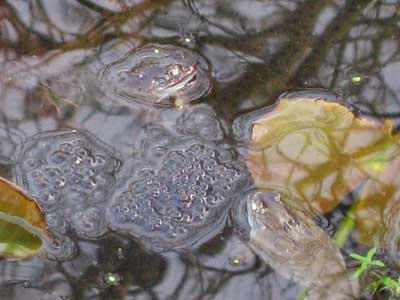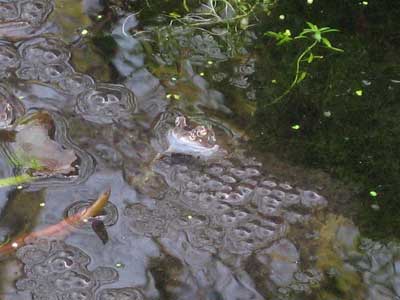Spurn Spawn!
By Ruth D’Alessandro, The Wildlife Gardener “We’ve got loads of frogspawn. Would you like some for your pond?” is the question most asked of the Wildlife Gardener at this time of year.

And when my answer is a firm “No thank you”, the response is usually “Why not? I’ve got far too much.” In the spring, the Wildlife Pond resembles a bowl of tapioca. The water boils with copulating amphibians and soon it is just a jellified mass. Surely far too much spawn? Why not take it out? Why not indeed? As regular readers of Notes from a Wildlife Garden will know, the Wildlife Pond is a carefully-managed, yet hands-off environment, extraordinarily rich in invertebrates and amphibians. Historically, it was the village’s spring-fed watering hole. Generations of healthy newts and frogs have returned to breed in its oaky waters. Frogspawn and tadpoles are a vital part of the food chain and support other pond creatures such as dragonfly and damselfly nymphs, diving beetles and water boatmen. They managed pretty well for thousands of years without human busybodies moving their spawn about. To take it out would deprive other species of their food. Every spawn is sacred.
Another regular question is:’how do I get frogs in my pond, then?’ The answer should delight the laziest gardener: just wait. They’ll come of their own accord soon enough, and with home-owners often filling in ponds because they’re afraid their children will drown in them, there’s no shortage of amphibians looking for a home. Another reason for not transporting spawn to other ponds is the risk of disease. In the 1980s, unusually high numbers of dead and dying frogs were found in South East England. Studies by the Institute of Zoology in London revealed they were infected with Ranavirus, misleadingly called’red-leg disease‘. Ranavirus affects frogs, toads and newts. Symptoms of this miserable affliction could include lethargy, wasting, redness of the skin, ulceration of the skin, haemorrhage and limb necrosis. Victims could show all or some of these symptoms, but often none at all. The most obvious sign that a pond is infected with Ranavirus is the presence of many dead or dying amphibians, more often out of the pond than in, and usually during the summer months.

All the Wildlife Pond’s multitudinous amphibians have been in rude health for the past two years. The Wildlife Pond may have had Ranavirus a few years ago: the previous owner tells me there were no frogs for a couple of years before we moved in. In that case, I am even more forceful with my rejection of proffered spawn: my amphibians may be developing immunity to the disease and I would not risk reinfecting them with a Ranavirus from spawn or tadpoles imported from another population. If you are unlucky enough to experience Ranavirus among amphibians in your garden, burn or bury the bodies (don’t put them in the dustbin ” you could spread the disease). Then, just sit it out, as the disease should pass through naturally, and the numbers should recover in the following years, as they have done in the Wildlife Pond. A bit of free frogspawn? Just Say No.
More info from Froglife: ‘Stop the Swap’
This post first published in 2009, updated with new links, 2014.
- Spurn Spawn! - 26th February, 2014
- Bluebells on wheels: axles of evil? - 2nd February, 2011
- Raising the ba: Wildlife and the Ancient Egyptian Book of the Dead - 8th January, 2011

Wise words, WG.
This subject was explored on the Kent Ornithological Society network a couple of weeks ago, with a lively debate!